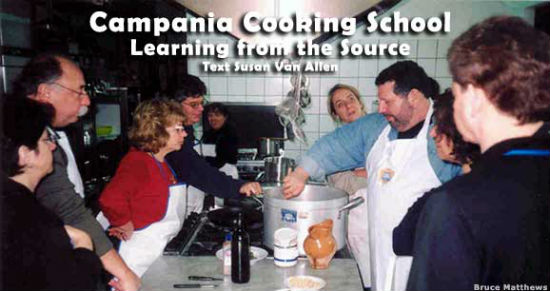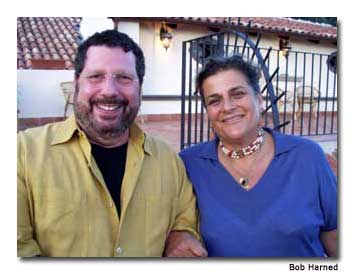

It was my turn to stir. I dipped a spoon into the pot of strained tomatoes, beef and sausage that had been simmering on the stove for two hours. Its deep red mahogany color and savory aroma took me back to my Nana’s kitchen in Newark, New Jersey. But outside, the sight of water buffalo grazing on stretched out green plains zapped me back to the present.
I was far from where I first tasted this sauce, yet paradoxically at its source — cooking in a farmhouse in southern Italy. It is in this region of Campania where the world’s best-known Italian foods, like thisragù napoletano (tomato and meat sauce) and pizza were born.
My husband and I met up in the ancient city of Paestum (founded as a Greek colony around 600 B.C.) with Arthur Schwartz, award-winning American cookbook author, teacher, and former host of New York’s daily “Food Talk” radio show. Four times a year Schwartz takes groups here on week-long culinary vacations that include cooking classes, visits to nearby Naples and Salerno, restaurants, wineries, and farms. For me — a grandchild of Italian immigrants — the trip was an experience that took me to the roots of the kitchens of my past.
The setting, on the green fertile Sele Plain in the region of Campania (an hour and a half south of Naples), is tranquil and unspoiled by tourists. Most visitors come to Paestum for a look at its main attraction — the three best preserved Greek temples in Europe — and then move on.
But our trip took us deep into the soul of the town — its farms, food and most importantly, its people. Arthur, who has been visiting the region for 30 years, learning from its cooks and making friends with the locals, opened the door for us.
I’d met Arthur through his book, “Naples at Table,” critically acclaimed as a “bible of regional cooking, history and lore.” In it were recipes for all my Nana’s dishes (which I’d never seen written down) and much more. Reading his passionate coverage of the area was a siren’s call to hop a plane and get in on the adventure.
Arthur’s co-host was Baronessa Cecilia Bellelli Bartta — as completely down-to-earth as Arthur, despite the regal title. Cecilia owns and operates Tenuta Seliano, her guest farm or agriturismo where we dined and lodged. Amidst fields of escarole, fennel, olive trees and horse stables, are three 18th-century stone farm buildings that have been converted for guest accommodations.
Our room, in the turreted portion of one of the buildings, looked from the outside as if it was straight out of a fairytale. Inside, it was chilly as a dungeon — though the carved mahogany bed and armoire from Cecilia’s antique collection gave it a cozy old world ambience.
We spent a good deal of our time in the downstairs dining room, where long family tables set a warm stage for lively and delicious mealtimes. Most of what we ate came directly from Cecilia’s farms — from the fig marmalade at breakfast to the Buffalo steaks.
“Taste this, you’re not going to believe it,” said my classmate, Flo, passing me a plate of amozzarella di bufala — a fresh stringy-textured white cheese made from whole buffalo milk. Flo and her husband, along with another couple (all four from Long Island, New York), had taken this same trip last year. As if initiating me, they watched as I took a bite and swooned over the creamy fresh burst in my mouth. “That’s nothing compared to what you’ll taste tomorrow at the buffalo farm,” laughed Flo’s husband, Ken.
Ken wasn’t kidding. The next morning we visited a caseificio, one of many mozzarella di bufalafactories that Paestum is renowned for. It was just another work day for the men in the small bright room stirring vats of hot milk, and the women gossiping around a tub as they finished off the process by stretching and pulling the white thickening cheese and then forming it into braids. For me, it was the day I tasted mozzarella in its primal state for the first time — such a delicious revelation that it’s spoiled me for any I’ve eaten since.
As a pair, Arthur and Cecilia could pass for brother and sister. Both are in their late 50s, with broad expressive faces, and a boundless enthusiasm to share their extensive knowledge of Campania’s cuisine.
Arthur’s Brooklyn born-and-bred sense of humor put us immediately at ease and eager to learn. Cecilia is the archetype of a gracious multi-tasking businesswoman. While helping teach class, she was also supervising the cooking assistants, and even arranging a car service for a classmate who mentioned she wanted to visit the mountain town of San Fele (an hour’s drive away) where her grandparents were born.
Class took place in the large white-tiled renovated kitchen of Cecilia’s second agriturismo, Masseria Eliseo, where she raises water buffalo. The eight of us students were given print-outs of recipes for the day, tied on our aprons, and with Arthur in the lead, the cooking party began.
It was a team effort as we chopped and stirred in the well-equipped kitchen to make a lunch of risotto with prosciutto (salt-cured, air-dried raw Italian ham) and mozzarella, escarole with pine nuts and olives, fried salt cod, and panna cotta (which means “cooked cream”), a molded chilled dessert.
But it was making timballo, a classic Campanian pastry drum filled with macaroni, meats, and cheese that truly bonded us. “There are about 24 versions of this,” said Arthur. An elaborate rendition oftimballo was featured in the 1996 movie “Big Night” starring Tony Shalhoub and Stanley Tucci, where the chefs obsessed about it for days and its presentation was the climax of the film.
Arthur’s version was simpler, but still a 20-step process — starting with making the ragù napoletano, then the pastry crust, and grating, chopping, and sautéing the filling ingredients. The two we made were sent over to be baked at Tenuta Seliano, where they would be served at a party along with othertimaballi made by the agriturismo’s regular cooks. I hoped ours wouldn’t stand out as student attempts…
That night we gathered in the dining room with over a hundred party guests — Cecilia’s relatives, friends, and Italian visitors. When the timballo was served, everyone at our table took out cameras to capture the moment. We spooned ragù over our wedges and tasted it, congratulating each other for a job deliciously done. A friend of Arthur’s rushed to our table to deliver the verdict I’d been waiting for, straight from Baronessa Cecilia’s brother-in-law: “Franco loved it!”
We toasted with prosecco (a refreshing sparkling wine), and danced between the tables, surrounded by faces that could pass for doubles of relatives I’d celebrated with so long ago. I felt a rush of them smiling down at me in joyful approval. I’d found my way back to the source.

If You Go
“Cook At Seliano Culinary Vacations” takes place four times a year. Cost is US$ 3,500 (for room, meals, classes, and side-trips, airfare is not included.)
718-783-2626
Agriturismo Seliano
Via Seliano
84063 Paestum
Italy
++ 39-0828-724544
Italian State Tourist Board
www.enit.it
